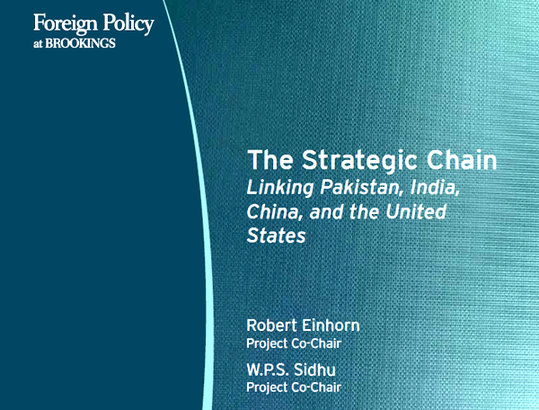The strategic chain concept and China
china.org.cn / chinagate.cn by Sabena Siddiqi, March 20, 2017 Adjust font size:
|
|
|
A recent Brookings report suggests that restraint between China and the U.S. would likewise encourage restraint between India and Pakistan. |
The Washington-based Brookings Institute is a highly influential think-tank which actively participates in U.S. policy-making. Recently it conducted an extensive 15 month research on the dynamics of the China-U.S. and Pakistan-India relations visualized as an inter-connected "strategic chain." The basic concept being that, "While Pakistan responds strategically to India, India responds both to Pakistan and China, which in turn responds both to India and the United States."
The Brookings report is timely, balanced and inclusive as scholars and retired senior officials from all four countries debated over strategic doctrines, strategic programs, measures of restraint and bilateral restraint management, as well as the convergence and divergence of mutual strategic interests.
The China-Pakistan equation was examined vis-a-vis U.S.-India ties. Especially after their nuclear and logistics deal, it was noted that these two sets of alliances set off the fastest growing nuclear and missile programs. Thus, a quadripartite solution is a must -- as bilateral engagement did not suffice.
The senior retired officials and academics representing China were: Professor Li Bin, Major General Yao Yunzhu, Zhao Tong and Ambassador Sha Zukang. Zhao Tong's paper, "China's Strategic Environment and Doctrine" highlights that the U.S./China relationship is China's most important bilateral relationship. Based on mutual economic interests, it seeks to maintain a stable international financial system along with a strong and open global economy. However, its rapid economic growth has narrowed the power gap and consequently, Washington seeks to contain Beijing.
Zhao Tong observes that, "Seeing that a power transition between Washington and Beijing is very likely in the mid- to long-term future, China worries that the deep ideological and political differences between the two countries will drive the United States to do everything to resist and prevent this power transition from happening."
His concern is that the U.S. may be using its alliances for containing and undermining China regionally. Previously, U.S. officials had acknowledged during Track 2 and Track 1.5 dialogues that Washington was willing to accept a mutual vulnerability relationship with China. But the recent "rebalance to Asia" strategy negates the previous standing. However, China is heading towards achieving an assured nuclear retaliation capability as its economy grows.
On South Asia, Zhao Tong states, "China also fears that the widening nuclear and conventional military gaps between India and Pakistan may also exacerbate a regional imbalance and threaten stability. As China significantly increases its investments in the region, through the China-Pakistan Economic Corridor and other investment projects, China has begun to hold much greater stakes in the overall stability of the region. The combination of terrorism and the nuclear security threat has drawn increasing Chinese concern as well."
To counter this aspect, the main Brookings report suggests that restraint by the United States and China might be a necessary precondition for the adoption of certain types of restraints by India and Pakistan.
Zhao Tong mentions that China felt strongly when President-elect Trump had taken a congratulatory call from Taiwan's leader, breaching a 35-year old diplomatic protocol between the U.S. and China, symbolizing a U.S. departure from its One China policy.
Notably, Japan, South Korea and North Korea present various nuclear challenges for Beijing and if the U.S. seeks a first-strike capability against China, it would be unsettling as the latter adheres to a strategy of minimum nuclear deterrence.
Additionally, "China also suspects that South Korea has decided to side more firmly with the United States by choosing to join the U.S. missile defense network and to deploy the THAAD system on its territory."
From the American side, Matthew Kroenig states, "With regard to China, the United States continues to seek a stable strategic relationship. While there are serious concerns in Washington about the increasingly competitive nature of many aspects of Sino-U.S. interactions, Washington's overriding objective remains the maintenance of strategic deterrence and stability. The United States understands that China will take whatever steps necessary to maintain an assured retaliatory capability and Washington does not believe that U.S. programs, current or planned, would pose a threat to China's nuclear deterrent." He further elaborates that the U.S. wishes to "maintain and strengthen strategic stability with China."
Finally, new geopolitical re-alignments further tense up the atmosphere in South Asia, with the "strategic chain" concept seeking to resolve this by initiating engagement and dialogue to stem reflex chain reactions between the four nations. The report assesses that "restraint between China and the U.S. likewise encourages restraint between India and Pakistan," consequently one platform is intrinsic towards resolving issues.
Overall, enhanced connections were established between the nations which have already resulted in collaborative measures and the resolve to continue the discussion further in future meetings. As Strategic Chain Project Coordinator James Tyson pointed out in the article "Existing Measures to Promote Stability in the 'Strategic Chain'," "The countries of the 'strategic chain' have undertaken some measures to promote strategic stability and reduce strategic uncertainty. These include declarations, memorandums of understanding (MOUs), confidence and security-building measures (CSBMs), and strategic dialogues."
The author is a geopolitical analyst at think tank Katehon, Pakistan.
Opinion articles reflect the views of their authors, not necessarily those of China.org.cn.
